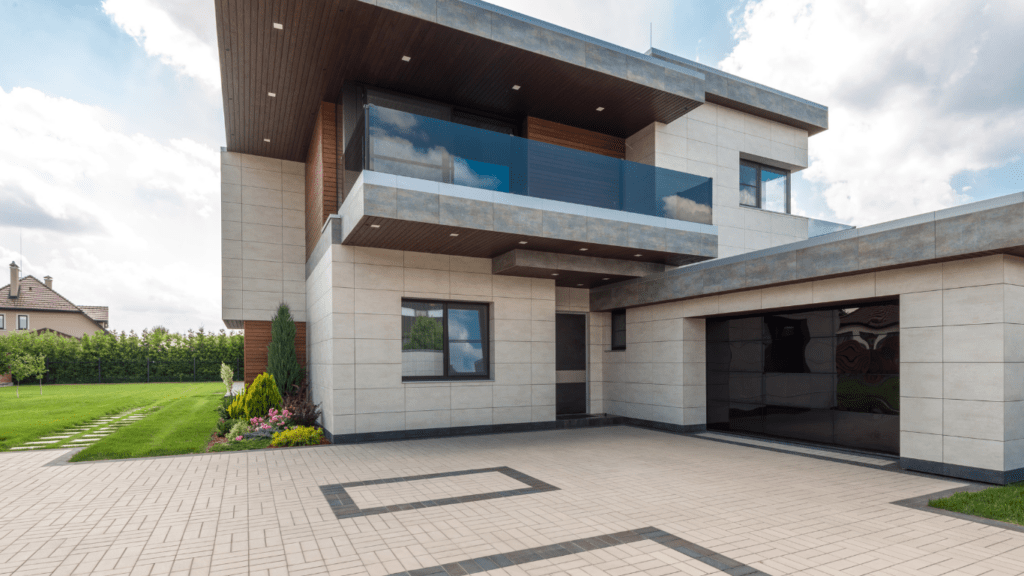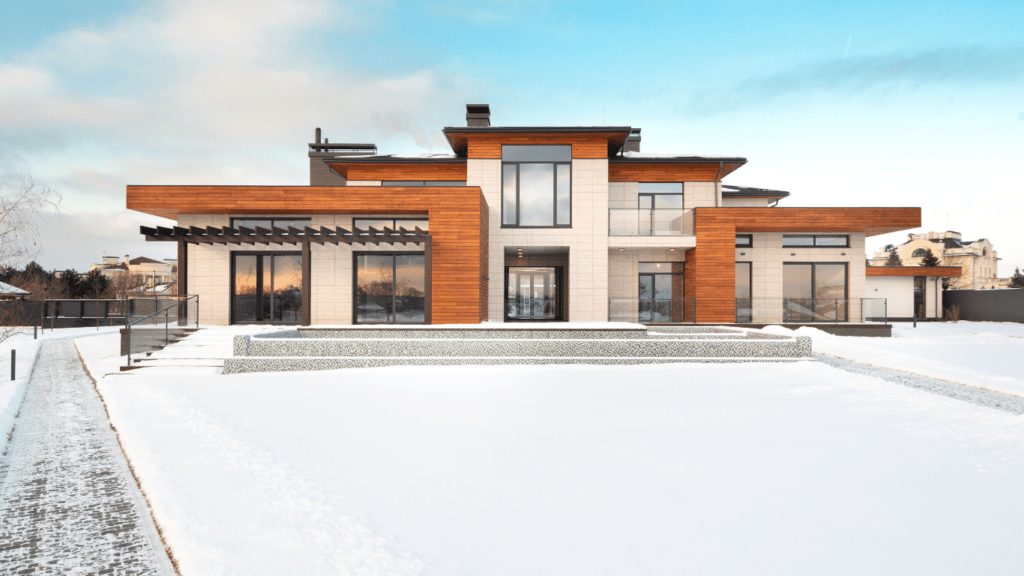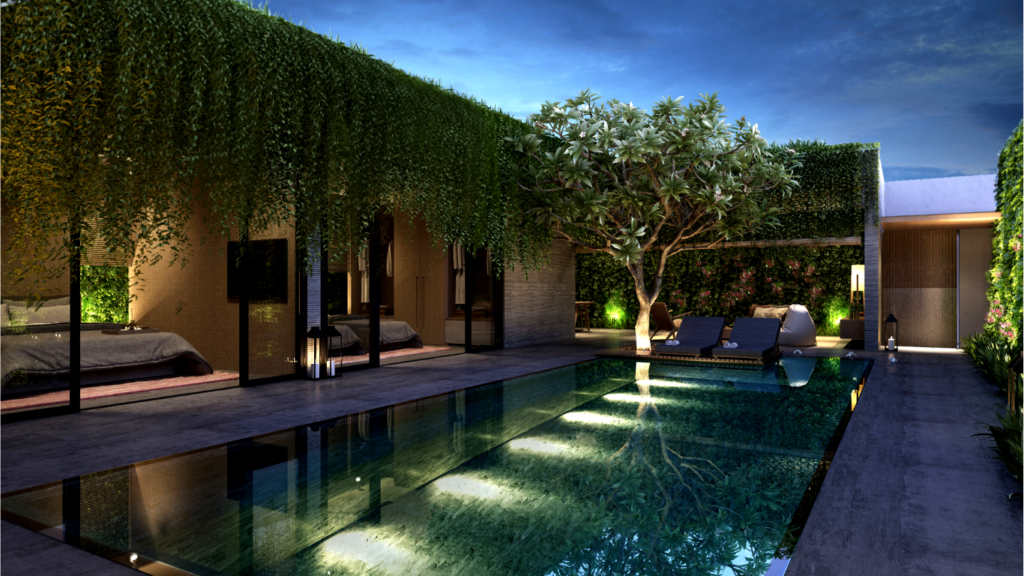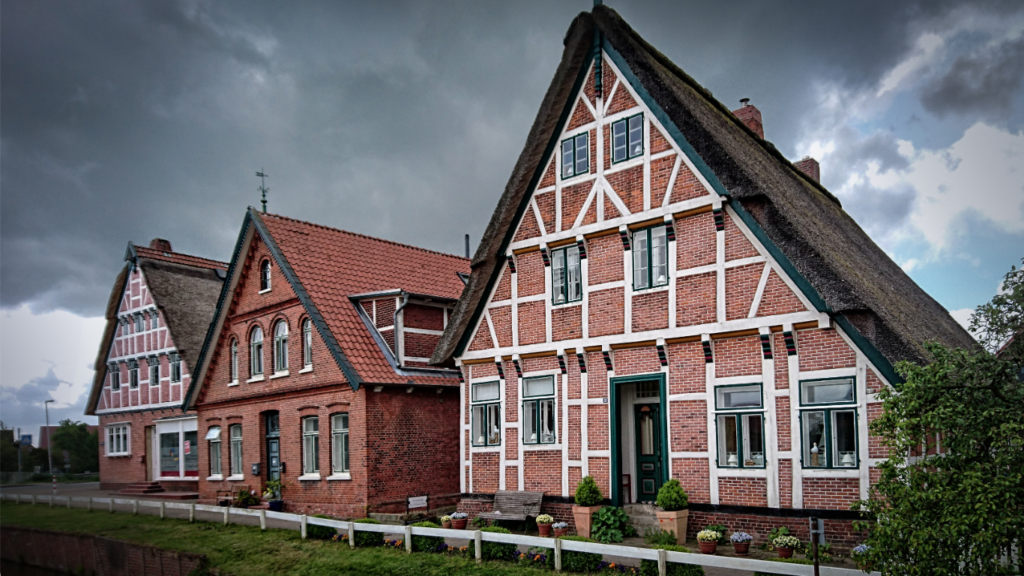Understanding Modern Facades
Modern facades merge beauty with practicality, influencing the building’s aesthetics and performance. They often feature clean lines, large glass panels, and materials like metal, concrete, and wood, creating a sleek and contemporary appearance.
Design Elements
- Clean Lines: Vertical and horizontal lines, defining the building’s structure.
- Large Glass Panels: Allow natural light, enhancing energy efficiency.
- Materials: Metal, concrete, and wood, each adding unique characteristics.
Functional Benefits
- Energy Efficiency: Insulated panels and double-glazing reduce energy consumption.
- Durability: Materials like metal and concrete ensure longevity.
- Low Maintenance: Many modern materials require minimal upkeep.
- Green Facades: Incorporate plants, improving air quality and thermal regulation.
- Smart Glass: Adjusts transparency, optimizing natural light.
- Mixed Materials: Combinations creating visually dynamic designs.
Modern facades are not just about looks. They integrate advanced technology and sustainable practices, making buildings more efficient, durable, and appealing.
Key Features of Modern Facades
Modern facades showcase distinctive elements that marry style with function. Key features include minimalist designs, natural integrations, and advanced materials.
Minimalist Aesthetics
Minimalist aesthetics dominate modern facades. Clean lines and simple forms create a sense of order. Large glass panels are popular, offering unobstructed views and ample natural light. Neutral color palettes like white, gray, and black enhance the sleek, understated look. Architectural elements like concealed gutters and low-profile roofs maintain visual simplicity while fulfilling practical needs.
Integration of Natural Elements
Nature plays a crucial role in modern facade design. Green walls and vertical gardens not only improve air quality but also add a unique visual appeal. Wood accents, whether through cladding or decorative features, soften the building’s appearance and introduce warmth. Water elements, like wall fountains, can be integrated for added tranquility. Additionally, open spaces and balconies often include plants, creating seamless indoor-outdoor transitions.
Use of Advanced Materials
Advanced materials elevate facade functionality. Aluminum and steel provide strength and durability while remaining lightweight. Insulated panels enhance energy efficiency. Smart glass technology adapts to changing light conditions, improving comfort and reducing energy costs. High-performance composite materials mimic the appearance of natural stone or wood without the associated maintenance. These materials not only improve performance but also contribute to the avant-garde aesthetic of modern facades.
Popular Design Trends
Modern facades continue to evolve, embracing sleek and stylish elements that significantly enhance a building’s exterior appeal. Here are some trends gaining popularity.
Glass and Steel Combos
Glass and steel combinations create a sleek, modern look for buildings. Large glass panels provide natural light, while steel frames offer strength and durability. The transparency of glass contrasts sharply with the industrial feel of steel, resulting in a balanced, contemporary design. Examples include skyscrapers with entire glass curtain walls supported by steel structures or residential homes with steel-framed glass windows.
Sustainable and Eco-friendly Facades
Sustainability in facade design promotes environmental responsibility. Green walls, for instance, incorporate plants to improve air quality and insulation. Facades made from recycled materials, like reclaimed wood or recycled aluminum, reduce waste. Solar panels integrated into facades also offer renewable energy sources. An example is the Bosco Verticale in Milan, which uses plant-covered facades to enhance biodiversity and air detoxification.
Bold Colors and Textures
Bold colors and varied textures make facades stand out. Designers use bright hues like reds and blues to create visual interest. Textured surfaces, such as ribbed concrete or patterned metal panels, add depth and dimension. These elements break the monotony and provide a striking contrast to minimalist designs. For example, commercial buildings often use colorful ceramic tiles or textured concrete surfaces to draw attention and create a unique aesthetic.
Practical Considerations
Modern facades offer a blend of aesthetics and functionality. However, it’s crucial to account for practical aspects when selecting materials and designs.
Energy Efficiency
Energy efficiency is vital in modern facade design. Using insulated panels, smart glass, and energy-efficient windows can significantly reduce energy consumption. For instance, triple-glazed windows provide superior insulation compared to double-glazed ones. Green facades with climbing plants can also offer natural insulation, reducing heating and cooling costs. Integrating solar panels into the facade design further enhances energy efficiency, turning the building into an eco-friendly structure.
Maintenance and Durability
Maintenance and durability determine the facade’s long-term performance. Opt for materials like high-quality stainless steel, aluminum, and treated wood to ensure longevity. For example, powder-coated aluminum offers a maintenance-free surface that resists corrosion. Regular maintenance tasks, such as cleaning glass panels and checking sealants, are easier with materials designed for minimal upkeep. Using durable materials not only reduces long-term costs but also maintains the facade’s appearance over time.
Inspiring Examples

Modern facades showcase cutting-edge designs that blend aesthetics with functionality. Below, I’ve highlighted some inspiring examples in both residential and commercial settings.
Residential Masterpieces
- Glass and Wood Harmony: Many contemporary homes feature large glass panels framed with wood. This combination offers transparency and warmth. For instance, a house with floor-to-ceiling windows provides expansive outdoor views while timber adds a natural touch.
- Minimalist Concrete Villas: Concrete facades, characterized by clean lines and neutral tones, are both sleek and durable. A minimalist villa boasting smooth concrete surfaces can emphasize simplicity and sophistication.
- Green Facades: Integrating plants into the facade creates a living wall that enhances air quality and aesthetic appeal. Consider a residence adorned with climbing ivy or modular green panels.
- Mixed-Material Marvels: Commercial buildings often use a mix of metal, glass, and stone. Such facades add texture and visual interest. An office tower blending steel and glass with marble accents stands out as a prime example.
- Smart Glass Innovations: Incorporating smart glass in commercial buildings regulates light and temperature. An innovative example would be a corporate headquarters that uses electrochromic glass to adjust opacity based on sunlight.
- Sustainable Designs: Commercial structures increasingly feature eco-friendly facades. A green skyscraper with integrated solar panels and rainwater harvesting systems exemplifies sustainability.
Choosing the Right Modern Facade
Choosing the right modern facade is essential to enhance a building’s aesthetic and functional value. Several factors influence the decision-making process.
Budget Considerations
Budget plays a crucial role in selecting a modern facade. High-quality materials like glass, steel, and treated wood offer durability and visual appeal but can be costly. It’s advisable to assess material costs and installation expenses to align with your budget. For instance, opting for aluminum might be more affordable than steel while still offering a sleek look. Energy-efficient options, such as insulated panels and smart glass, may require a higher initial investment but can reduce long-term energy costs. Identify a balance between upfront expenditure and potential savings over time.
Balancing Style and Functionality
Balancing style and functionality ensures that the facade meets aesthetic preferences while serving practical purposes. Clean lines and minimalist designs provide a contemporary look, though integrating functional elements like ventilated facades enhances performance.
Materials like smart glass, which adjusts transparency, offer aesthetic elegance paired with energy efficiency. Additionally, integrating green facades can improve air quality and add visual interest.
Consider durability and maintenance, favoring materials like stainless steel and treated wood that offer long-term benefits without compromising style. Evaluate how elements like natural lighting, insulation, and weather resistance align with design goals to achieve a harmonious facade.



 Betsylie Sheetsin – Home Renovation Expert
Betsylie Sheetsin serves as the Home Renovation Expert at Castle Shelf House, specializing in giving practical advice for both small and large-scale home improvements. With years of experience in construction and renovation, Betsylie understands the importance of blending durability with design. Her insights into home renovation projects, along with expert advice on the latest materials and techniques, empower homeowners to tackle even the most ambitious projects confidently.
Betsylie Sheetsin – Home Renovation Expert
Betsylie Sheetsin serves as the Home Renovation Expert at Castle Shelf House, specializing in giving practical advice for both small and large-scale home improvements. With years of experience in construction and renovation, Betsylie understands the importance of blending durability with design. Her insights into home renovation projects, along with expert advice on the latest materials and techniques, empower homeowners to tackle even the most ambitious projects confidently.
